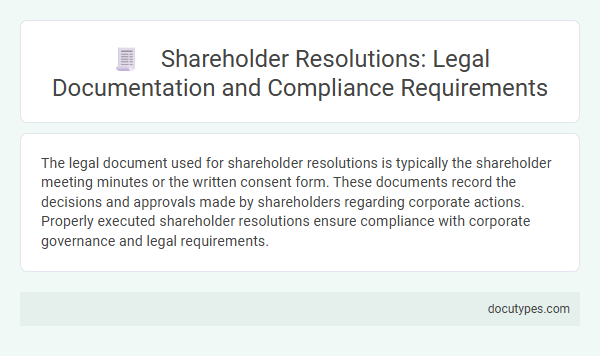The legal document used for shareholder resolutions is typically the shareholder meeting minutes or the written consent form. These documents record the decisions and approvals made by shareholders regarding corporate actions. Properly executed shareholder resolutions ensure compliance with corporate governance and legal requirements.
Introduction to Shareholder Resolutions
Shareholder resolutions are formal proposals submitted by shareholders for a vote at a company's annual general meeting or special meeting. These resolutions address various corporate governance issues, including executive compensation, environmental policies, and corporate social responsibility. The primary legal document used for shareholder resolutions is the proxy statement, which provides detailed information about the proposals to assist shareholders in making informed voting decisions.
Legal Framework Governing Shareholder Resolutions
What legal document is used for shareholder resolutions? The primary legal document governing shareholder resolutions is the company's Articles of Association, which outlines the procedures and powers related to shareholder decisions. Corporate bylaws and applicable corporate governance laws also provide a framework to ensure resolutions comply with statutory requirements.
Types of Shareholder Resolutions
Legal documents used for shareholder resolutions formalize decisions made during shareholder meetings. These documents ensure clarity and enforceability of the resolutions voted on by shareholders.
- Binding Resolutions - These are legally enforceable decisions that require mandatory compliance by the board or management.
- Non-Binding Resolutions - Also known as advisory resolutions, they express shareholder opinions without legal obligation.
- Ordinary Resolutions - Passed by a simple majority, these resolutions typically address routine corporate matters like electing directors.
Drafting Shareholder Resolutions: Key Legal Considerations
Shareholder resolutions are formal documents used to propose and approve decisions within a corporation. These resolutions are typically drafted to address matters such as corporate governance, policy changes, or financial decisions.
Drafting shareholder resolutions requires careful attention to legal requirements under the company's bylaws and applicable corporate laws. The resolution must clearly state the purpose, specify the proposed action, and include precise language to avoid ambiguity. Proper documentation ensures enforceability and provides a clear record for shareholders and regulatory bodies.
Statutory Requirements for Valid Resolutions
Shareholder resolutions are formal decisions made during a company's general meetings, documented through specific legal instruments. The most commonly used legal document for these resolutions is the "Written Resolution" or "Minutes of Meeting," which must comply with statutory requirements to be valid.
- Written Resolution - A legally binding document recording shareholder decisions without a physical meeting, adhering to company law regulations.
- Minutes of Meeting - Official records of discussions and resolutions passed during a shareholders' meeting, ensuring transparency and compliance with legal standards.
- Statutory Compliance - Resolutions must meet filing deadlines, proper notice provisions, and quorum rules as stipulated by the Companies Act or applicable corporate law.
Your shareholder resolutions hold legal weight only if these statutory conditions are strictly followed and properly documented.
Notice and Meeting Procedures
| Legal Document | Purpose | Key Components | Notice Requirements | Meeting Procedures |
|---|---|---|---|---|
| Notice of Shareholder Meeting | Formally informs shareholders of the upcoming meeting where resolutions will be discussed and voted on. | Meeting date, time, location, agenda including specific shareholder resolutions. | Must be delivered within a timeframe defined by corporate bylaws or state law, typically 10 to 60 days prior to the meeting. Must specify all matters to be considered. | Ensures shareholders have timely access to information and can prepare to participate in voting or discussions. |
| Proxy Statement | Informs shareholders about the details of resolutions and allows shareholders to vote by proxy if unable to attend the meeting. | Summary of each resolution, voting instructions, proxy forms. | Required to be sent along with the notice of meeting, enabling shareholders to make informed decisions. | Facilitates shareholder participation and voting even without physical attendance. |
| Minutes of the Meeting | Records the official decisions and resolutions approved during the shareholder meeting. | List of attendees, motions made, votes cast, final outcome of resolutions. | Notices precede meeting, but minutes are distributed after to document proceedings. | Ensures legal compliance and creates an official record of your shareholder resolutions and meeting discussions. |
Voting Thresholds and Approval Criteria
Shareholder resolutions are formal proposals presented for a vote during a company's annual general meeting or special meeting. These resolutions require specific legal documents outlining voting thresholds and approval criteria to ensure proper governance.
- Proxy Statement - This document provides detailed information on the shareholder resolution, including voting instructions and required approval percentages.
- Notice of Meeting - It officially informs shareholders about the resolution's agenda and specifies the voting thresholds necessary for adoption.
- Shareholder Agreement - Outlines the approval criteria for resolutions, often specifying higher voting thresholds for major decisions affecting ownership or control.
Documentation and Recordkeeping Obligations
The primary legal document used for shareholder resolutions is the meeting minutes, which officially record the decisions made during shareholder meetings. Proper documentation includes detailed minutes, signed by the chairperson, capturing the resolution's purpose, vote count, and outcomes. Maintaining accurate records ensures compliance with corporate governance regulations and facilitates future reference for audits and legal verification.
Compliance with Regulatory Authorities
The legal document used for shareholder resolutions is typically known as a "Shareholder Resolution Proposal" or "Written Consent." This document formally records the decisions made by shareholders regarding corporate governance and significant company actions.
Compliance with regulatory authorities requires that your shareholder resolutions adhere to the specific filing and disclosure requirements set forth by securities regulators, such as the SEC in the United States. Proper documentation ensures transparency and legal validity in corporate decision-making processes.
What Legal Document Is Used for Shareholder Resolutions? Infographic

